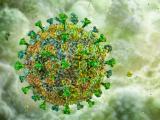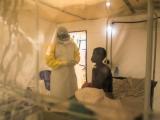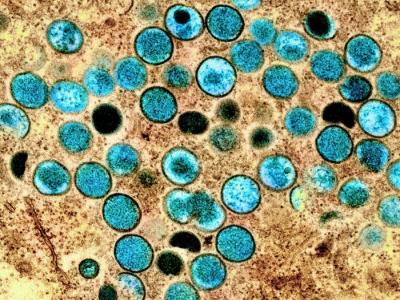The Ebola virus strain responsible for Guinea's outbreak—now at 197 suspected or confirmed cases—is a new strain that has been sickening and killing people at least as far back as December, researchers reported yesterday.
The results of full genetic sequencing suggest that the outbreak in Guinea isn't related to others that have occurred elsewhere in Africa, according to an international team that published its findings online in the New England Journal of Medicine (NEJM).
The report is also the first detailed look at the epidemiologic features among the patients sickened in the early days of the outbreak in the forested region of Guinea, sketching out transmission chains that start with a 2-year-old girl who died in December.
Latest WHO numbers
As of yesterday, 197 suspected or confirmed Ebola virus disease (EVD) cases have been reported in Guinea, an increase of 29 since Apr 14, the World Health Organization (WHO) said in an update today. Fourteen more deaths were reported, raising the total to 122.
The WHO added that 101 cases have been lab confirmed. So far 47 of the cases, along with 16 of the deaths, have been in Conakry, the country's capital. Most of the others have been reported from the forested region in the southeastern part of the country where the outbreak began.
A team of 60 volunteers is helping the health ministry conduct contact tracing in Conakry, where 23 patients are still in isolation. Thirteen more case-patients are being treated in isolation units in Gueckedou (12) and Macenta (1).
In Liberia, 1 new EVD cases was reported, raising the total there to 27, while the number of deaths held steady at 13, according to the WHO statement. It said a suspected case reported yesterday from Nimba County has tested positive for Lassa fever. Two patients are still hospitalized, and health officials are still monitoring 33 contacts.
As part of response efforts in Liberia, the country's health ministry yesterday commissioned a new Ebola virus laboratory, a collaboration with Metabiota, a San Francisco–based infectious disease investigation group. Also, the health ministry and its global health partners visited two hospitals, where they conducted their first training in case management, triage, and infection control.
Meanwhile, Mali's health ministry reported yesterday that clinical samples from six suspected cases were negative for EVD. Tests on the samples were conducted at the WHO collaborating center at the Pasteur Institute in Senegal and at a mobile high-security lab at the University of Bamako.
In Sierra Leone, 12 suspected cases have been identified since Mar 19, but tests on clinical samples from 11 of them were negative for Ebola virus and other pathogens, according to the WHO. Health officials are following up on rumors of EVD cases and conducting active case finding.
So far no EVD cases have been detected in Sierra Leone, though two patients who died from the disease in Guinea earlier in the outbreak were brought back to Sierra Leone for burial.
Clinical features, genetic analysis
In the NEJM report, researchers said Guinea's health ministry first learned of clusters of a highly fatal mysterious disease that had been occurring in two cities in the forested region on Mar 10. The finding triggered an epidemiologic investigation by a European team from Doctors without Borders (Medecins Sans Frontieres) and prompted the collection of blood samples and clinical data from 20 patients, which were sent to biosafety level 4 labs for analysis in Lyon, France, and Hamburg, Germany.
Fifteen of the patients tested positive for the virus using conventional filovirus tests, and electron microscopy identified the Ebola virus in the serum of one patient. Researchers isolated the virus from cell culture in samples from five patients.
The team's genetic analysis found a high degree of similarity among 15 partial and 3 full-length sequences. Meanwhile, their full-length sequence analysis revealed that the Ebola clade is separate from other known viruses of its kind.
Clinical investigation found that the most common symptoms among confirmed case-patients were fever, severe diarrhea, and vomiting, but hemorrhage was less common. The case-fatality rate (CFR) of initial cases was 86% and for suspected cases was 71%, consistent with EVD.
Three fruit bat species that are thought to harbor Ebola viruses are found in large parts of West Africa, and the first outbreak in Guinea serves as a warning that the whole West African region is at risk for the disease, the team concluded.
Evidence of single introduction
The group's look back at the transmission chains found that the first suspected case was a 2-year-old girl from Gueckedou prefecture who died in early December. They also found that an infected health worker from the same part of Guinea appears to have spread the virus to Macenta, Nzerekore, and Kissidougou in February. As the outbreak grew, 13 of the confirmed cases could be linked to four clusters.
Researchers concluded that genetic evidence and epidemiologic links between the cases suggests a single introduction of the virus from animals to humans, which could have occurred in early December or before. They wrote that they suspect the virus was transmitted for months before clusters of cases in Gueckedou and Macenta signaled that an outbreak was under way.
Hemorrhage wasn't documented for most of the patients when blood samples were obtained, but could have occurred later, the team noted. They said, however, that the term "Ebola virus disease" was developed to emphasize that hemorrhage isn't seen in all patients. The researchers said the CFR is consistent with previous Ebola outbreaks.
That the Guinea Ebola strain is a separate clade suggests that the pathogen that sparked the outbreak evolved parallel with those seen in the Democratic Republic of Congo and Gabon and was not introduced into Guinea—the first West African nation to experience an Ebola outbreak—from those countries.
See also:
Apr 16 N Engl J Med report
Apr 17 WHO update

















